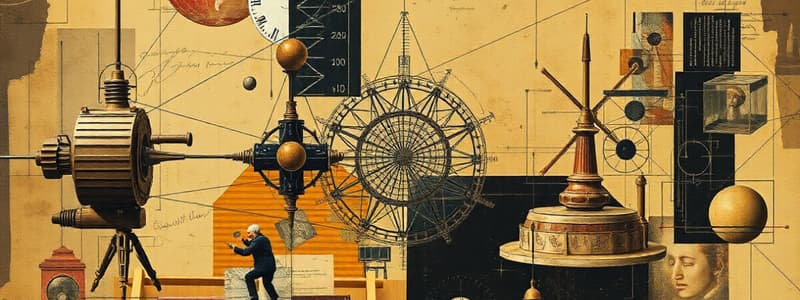Podcast
Questions and Answers
What does Newton's first law of motion state?
What does Newton's first law of motion state?
- An object in motion will accelerate unless acted upon by an unbalanced force.
- An object at rest will stay at rest unless acted upon by an unbalanced force. (correct)
- For every action, there is an equal and opposite reaction.
- Acceleration is directly proportional to mass and force.
Which law states that energy cannot be created or destroyed?
Which law states that energy cannot be created or destroyed?
- Law of conservation of momentum
- First law of thermodynamics (correct)
- Second law of thermodynamics
- Third law of thermodynamics
What relationship does Ampere's law describe?
What relationship does Ampere's law describe?
- The relationship between electric charges and their potential energy.
- The interaction between wave properties and particle properties of light.
- The relationship between electric current and magnetic field. (correct)
- The relationship between temperature and pressure in a gas.
Which concept describes light's ability to bend when passing through different media?
Which concept describes light's ability to bend when passing through different media?
What describes the tendency of an isolated system's entropy over time?
What describes the tendency of an isolated system's entropy over time?
Which statement is true regarding wave-particle duality of light?
Which statement is true regarding wave-particle duality of light?
What is the formula representing Newton's second law of motion?
What is the formula representing Newton's second law of motion?
What is a key concept in quantum mechanics?
What is a key concept in quantum mechanics?
What principle states that certain pairs of physical properties cannot be known with perfect accuracy simultaneously?
What principle states that certain pairs of physical properties cannot be known with perfect accuracy simultaneously?
Which model describes the atom as having a nucleus with orbiting electrons in specific energy levels?
Which model describes the atom as having a nucleus with orbiting electrons in specific energy levels?
What concept in relativity describes the effect of time passing at different rates for observers in different frames of reference?
What concept in relativity describes the effect of time passing at different rates for observers in different frames of reference?
Which of the following applications is commonly associated with quantum mechanics?
Which of the following applications is commonly associated with quantum mechanics?
Which key concept in general relativity describes the effect of mass on the curvature of spacetime?
Which key concept in general relativity describes the effect of mass on the curvature of spacetime?
Flashcards
Newton's First Law
Newton's First Law
An object at rest stays at rest and an object in motion stays in motion with the same speed and in the same direction unless acted upon by an unbalanced force.
Newton's Second Law
Newton's Second Law
The acceleration of an object is directly proportional to the net force acting on it and inversely proportional to its mass (F = ma).
First Law of Thermodynamics
First Law of Thermodynamics
Energy cannot be created or destroyed, only transformed from one form to another.
Second Law of Thermodynamics
Second Law of Thermodynamics
Signup and view all the flashcards
Electromagnetism
Electromagnetism
Signup and view all the flashcards
Quantum Mechanics
Quantum Mechanics
Signup and view all the flashcards
Wave-Particle Duality
Wave-Particle Duality
Signup and view all the flashcards
Classical Mechanics
Classical Mechanics
Signup and view all the flashcards
Heisenberg's Uncertainty Principle
Heisenberg's Uncertainty Principle
Signup and view all the flashcards
Atomic Physics
Atomic Physics
Signup and view all the flashcards
Bohr Model
Bohr Model
Signup and view all the flashcards
Study Notes
Classical Mechanics
- Classical mechanics describes the motion of macroscopic objects, using Newton's laws of motion.
- Newton's first law states that an object at rest stays at rest and an object in motion stays in motion with the same speed and in the same direction unless acted upon by an unbalanced force.
- Newton's second law states that the acceleration of an object is directly proportional to the net force acting on it and inversely proportional to its mass. Mathematically, F = ma.
- Newton's third law states that for every action, there is an equal and opposite reaction.
- Concepts of force, mass, momentum, energy, work, and power are fundamental in classical mechanics.
- Applications include satellite trajectories, projectile motion, and the behavior of everyday objects.
Thermodynamics
- Thermodynamics deals with heat, work, and temperature.
- The first law of thermodynamics states that energy cannot be created or destroyed, only transformed from one form to another.
- The second law of thermodynamics states that the entropy of an isolated system can only increase over time.
- The third law of thermodynamics states that the entropy of a system approaches a constant value as the temperature approaches absolute zero.
- Key concepts include enthalpy, entropy, and free energy.
- Applications are found in engines, refrigerators, and other thermal devices.
Electromagnetism
- Electromagnetism describes the interaction between electric charges and magnetic fields.
- Coulomb's law describes the electrostatic force between two charged particles.
- Gauss's law relates the electric field to the enclosed charge.
- Ampere's law relates magnetic fields to electric currents.
- Faraday's law describes the generation of an electromotive force (EMF) by a changing magnetic field.
- Applications are numerous, including electrical circuits, motors, generators, and electromagnetic waves, including light.
Optics
- Optics deals with the behavior and properties of light.
- Light can be described as both a wave and a particle, this is known as wave-particle duality.
- Reflection, refraction, and diffraction are key concepts regarding light's interaction with surfaces and materials.
- Lenses and mirrors are used to manipulate light's path.
- Applications range from telescopes and microscopes to fiber optics and laser technology.
Quantum Mechanics
- Quantum mechanics describes the physics of the microscopic world, including atoms and subatomic particles.
- Key concepts include wave-particle duality, quantization of energy, and uncertainty principle.
- Heisenberg's uncertainty principle states that certain pairs of physical properties, like position and momentum, cannot be known with perfect accuracy simultaneously.
- Quantum mechanics has revolutionized our understanding of matter and energy at the atomic and subatomic level.
- Applications include the development of lasers, transistors, and modern electronics.
Atomic Physics
- Atomic physics explores the structure and behavior of atoms.
- Bohr model describes the atom as having a nucleus with orbiting electrons in specific energy levels.
- Quantum mechanical model provides a more accurate description of electrons in orbitals.
- Spectroscopy is a key tool for studying atomic structures and transitions between energy levels.
- Applications are in understanding matter, chemical reactions, and the development of new materials.
Relativity
- Relativity describes the relationship between space and time, particularly at high speeds and in strong gravitational fields.
- Special relativity deals with the relationship between space and time for observers in uniform motion.
- General relativity describes the relationship between space, time, gravity, and the distribution of matter and energy.
- Key concepts in relativity are spacetime, time dilation, length contraction, and gravitational fields.
- General relativity has implications in astrophysics, cosmology, and the study of black holes.
Studying That Suits You
Use AI to generate personalized quizzes and flashcards to suit your learning preferences.



